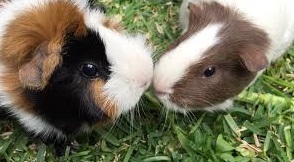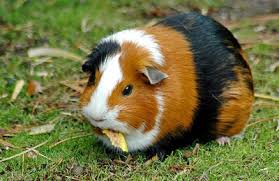
Guinea pig
(Cavia porcellus)

Conservation status
Leas concern
Scientific classification |
|
| Kingdom: | Animalia |
| Phylum: | Chordata |
| Class: | Mammalia |
| Order: | Rodentia |
| Family: | Caviidae |
| Genus: | Cavia |
| Specie: | Cavia porcellus |
Description

Cavia porcellus is a hybrid domestic species of histricomorphic rodents of the Caviidae family, resulting from the crossing of several species of the Cavia genus made in the Andean region of South America, with archaeological records found from Colombia and Ecuador to Peru and Bolivia. It reaches a weight of up to 1 kg. Live between five and eight years.
In Spanish, Cavia porcellus receives diverse vulgar names according to the country. In its zone of origin (Colombia, Ecuador and Peru) it is known as cuy (Quechua Quwi), an onomatopoeic name that still bears in some regions of South America. Mainly in this continent, although also in Mexico and Central America, there are several forms that have emerged from the onomatopoeic Quechua Quwi name: cuye, cuyi, whose, cuilo, cuis. In countries of the Caribbean area, Andalusia and the Canary Islands, the name presents variants such as curi, acure, curí, curío, cury. In the Central Sierra of Peru Huánuco, Ancash, Pasco, Junín, it is known as Jaka.
Its domestication for human consumption occurred 2500 years ago in the Central Andes, specifically in the department of Junín (Peru), in the same region where the domestication of alpacas took place, and over time, the Andean man has raised guinea pigs. to consume their meat and even in some areas to make clothes with their skin; A clear example is given in the Ecuadorian highlands. In the Andean countries there is a stable population of more or less 35 million guinea pigs, with Peru being the one with the highest consumption and population of guinea pigs, with an annual consumption of more than 65 million guinea pigs, produced by a more or less stable population of guinea pigs. 22 million animals reared basically with family production systems The estimated population of self-consumption in Ecuador is 15 million head of guinea pigs, something much lower than commercial production, which is estimated at 50 million.
Another reason for the breeding of this rodent is to market it as a companion animal.
The guinea pig is a very common animal for experimentation in biomedical research, hence the expression guinea pig or guinea pig is popularly used as a synonym for experimentation.
Nowadays he is raised more and more to have him as a pet, to be able to live with small children. As such, the so-called cuy of type 3 has been preferred; that is, the long-haired and straight guinea pigs called "Angora guinea pigs". Although some species of short hair are also preferred as pets.
Those of which are herbivorous animals, so that the supply of fiber in the food is essential. On the other hand, the contribution of vitamin C is highly necessary, because guinea pigs, primates and bats are the only species that do not synthesize this vitamin and if they are not provided with vitamin C, they can be scurvy and die, so pepper, orange and guava should be included in their diet. A well-balanced diet should consist of fresh vegetables, hay, water, all supplemented with croquettes or commercial food.
Zoológico de Vallarta A. C.
Leave your comments, your opinion is important to us

